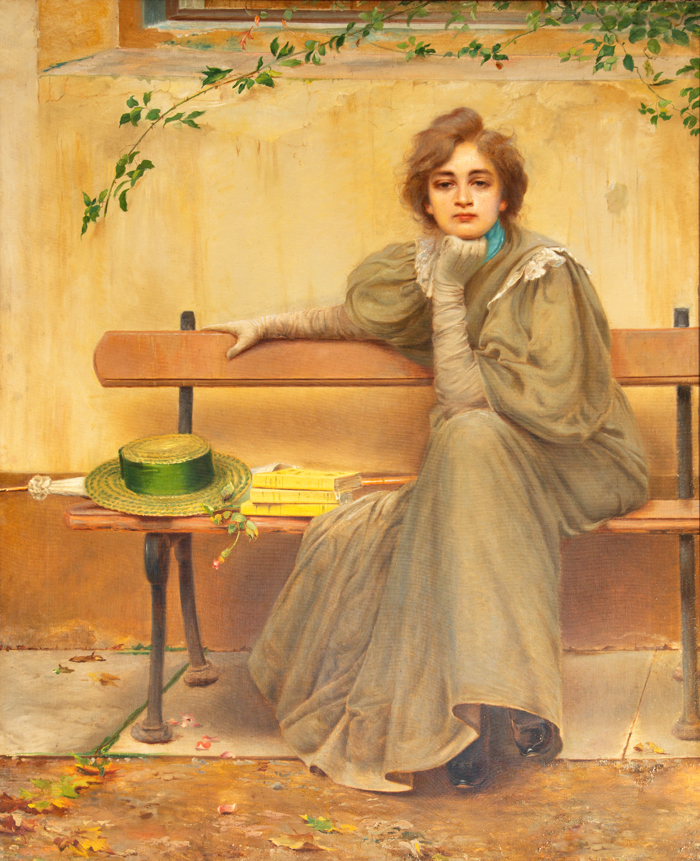Carrara, renowned worldwide for its high-quality marble, is not just a destination for architecture and sculpture enthusiasts. This year, the city invites visitors to embark on a fascinating journey through the history of Italian art with the exhibition Belle Époque: The Italian Painters of Modern Life.
On display at the historic Palazzo Cucchiari until October 27, 2024, this exhibition offers an in-depth look at the evolution of Italian painting during the Belle Époque, a period marked by profound social, cultural, and artistic transformations.
Table of Contents
The Belle Époque: A Period of Transformation
The Belle Époque, a term evoking an era of prosperity and progress in Europe from the late 19th century to the early 20th century, was a time of great transformation.
In Italy, this historical moment coincided with significant changes following the country’s unification, directly influencing the arts.
The exhibition in Carrara explores how Italian artists of the time responded to these changes, reflecting the complexities of a rapidly evolving society.
The Exhibition: A Journey Through Modernity
Curated by Massimo Bertozzi, the exhibition presents around 90 artworks, including oil paintings, watercolors, pastels, and sculptures in bronze and plaster, spanning from 1864 to 1917.
Bertozzi’s meticulous curation allows visitors to follow the evolution of Italian art from the final breaths of the Macchiaioli movement to the innovative fervor of Divisionism and the early signs of Futurism.
The exhibition is organized into seven main thematic sections, each offering a unique perspective on how Italian artists approached the themes of modernity:
1. Tempi Moderni: Urban Life and the New Stage of Action
The first section, Tempi Moderni (Modern Times), highlights how Italian artists began to explore urban life, a striking contrast to the rural landscapes and pastoral scenes that had previously dominated Italian art.
With the growth of cities and the advent of new technologies such as trains and electric lighting, streets, squares, parks, and public gardens became new spaces of artistic inspiration.
The artworks in this section capture the energy and diversity of urban scenes, reflecting the search for a more dynamic and cosmopolitan lifestyle.
2. Casa e Famiglia: The Domestic Space as a Reflection of Society
Casa e Famiglia (Home and Family) explores the transformation of home life and the family during the Belle Époque. During this period, residences were not just private spaces but also places for public display.
Living rooms, dining rooms, and libraries became symbols of status and culture, reflecting the rise of the bourgeoisie and their new social priorities.
The paintings in this section reveal the artists’ fascination with everyday life, capturing both the opulence and the simplicity of Italian homes.
3. I Pittori della Vita Moderna: The Artist as a Social Figure
The section I Pittori della Vita Moderna (The Painters of Modern Life) offers insight into the growing appreciation of artists as social and cultural figures.
As prosperity increased, artists were no longer seen as bohemian outcasts but as respected members of society. Their studios, families, and even themselves became popular subjects in the art of the time.
This period marked the beginning of a new relationship between art and society, where artists began to enjoy a higher status, attending salons and exclusive circles.
Intermezzo: Sculpture Between Romanticism and Modernism
The Intermezzo of the exhibition is dedicated to sculpture, a field that, during the Belle Époque, oscillated between romanticism and modernist anxieties.
This section showcases works that capture the tensions between religious mysticism and new forms of spirituality and worldliness.
Visitors can admire sculptures ranging from the lyrical symbolism of Leonardo Bistolfi to the aristocratic elegance of Paolo Troubetzkoy, which synthesize the artistic changes of the period.
4. Vecchi e Nuovi Miti: In Search of New Horizons
In Vecchi e Nuovi Miti (Old and New Myths), the exhibition explores how modernity sparked the search for new experiences and escapes.
This section addresses themes such as exoticism and spirituality, reflecting the growing fascination with distant cultures and mystical practices.
The artworks in this section show how artists captured these new aspirations and desires, often experimenting with colors, forms, and symbols to express the complexity of the modern soul.
5. Povera Patria: The Reality of New Italy
Povera Patria (Poor Homeland) offers a sober view of post-unification Italy, a period of both hope and disillusionment.
This section explores how artists depicted the social and economic realities of the country, including poverty and the aspirations of the Italian people.
The works in this section serve as a poignant reminder that, despite progress, many Italians still faced difficult living conditions.
6. Il Paradiso delle Signore: The Social Rise of Women
Il Paradiso delle Signore (The Ladies’ Paradise) highlights the role of women in Belle Époque society.
This section explores how women began to gain visibility in public spaces such as theaters, cafés, and salons. The paintings depict ladies in elegant settings, reflecting the growing importance of fashion and appearance in social life.
However, the section also hints at the limitations that persisted, with many women still confined to the roles of wives and mothers, even as awareness of their rights and capabilities was on the rise.
7. Aspettando Domani: Symbolism and Futurism on the Horizon
Finally, Aspettando Domani (Waiting for Tomorrow) explores the abandonment of naturalism and the search for new forms of expression.
Divisionist painting, which fragments light and color to create a new visual aesthetic, is presented as the foundation of Italian symbolism and a precursor to the Futurist avant-garde movements.
This section shows how artists began to look beyond the present, seeking to capture the realities of dreams and the mysteries of symbolism, laying the groundwork for the artistic movements that would define the 20th century.
A Masterpiece: Sogni by Vittorio Corcos
Among the many works on display, one that will undoubtedly captivate visitors is Sogni (Dreams) by Vittorio Corcos, painted in 1896.

This portrait of a young woman, with her enigmatic expression and introspective pose, has become an icon of 19th-century Italian art.
Curator Massimo Bertozzi describes the figure as one of the most evocative in 19th-century painting, representing a symbol of the new modern woman – intellectual, reflective, and restless.
The model’s identity, Elena Vecchi, the daughter of a writer and sailing pioneer, adds an element of mystery to the work, making it even more fascinating.
Plan Your Visit – Belle Époque in Carrara
How to Get There
The exhibition Belle Époque: The Italian Painters of Modern Life is on display at Palazzo Cucchiari, located at Via Cucchiari 1, Carrara.
Carrara is approximately 45 minutes away from Lucca, 50 minutes from Pisa, and just under 2 hours from Florence.
For those traveling from Genoa, the trip takes about 1.5 hours. From Milan, the drive is just under 3 hours.
By Car: The main highway to reach Carrara is the A12 (Genoa-Livorno). The exit for Carrara is just a few kilometers from the city center.
By Train: The nearest train station to the center of Carrara is Carrara-Avenza, located approximately 4 km away. It is connected to the center by public buses (Line 70, which does not operate on Sundays) or taxis (not available on Sundays). The Massa Centro station is about 10 km from Palazzo Cucchiari.
Opening Hours for the Belle Époque Exhibition
The exhibition will be open on August 15th, the Ferragosto holiday!
Visiting hours vary, with entry available from Tuesday to Sunday.
Until September 15, 2024, the palace is open from 9:30 AM to 12:30 PM and 4:00 PM to 8:00 PM, with extended hours until 11:00 PM on Fridays and Saturdays.
Starting September 17, 2024, hours will be from 9:30 AM to 12:30 PM and 3:00 PM to 8:00 PM, with closing at 9:00 PM on Fridays and Saturdays.
The exhibition will be open until October 27, 2024.
Belle Époque Exhibition Tickets in Carrara
Tickets can be purchased directly at the venue on the day of your visit. Prices are as follows:
| Category | Price |
|---|---|
| Adults | Euro 10.00 |
| Members of COOP LIGURIA UNICOOP FIRENZE UNICOOP TIRRENO | Euro 8.00 |
| Ages 0-17 | Free |
For more information, visit the official website here.
The Importance of the Belle Époque in Italian Art
The Belle Époque marked a transitional era in Italy, where art began to reflect the profound social, political, and economic changes shaping the country.
The rise of a new bourgeoisie, urban development, and technological innovations directly influenced the themes and techniques of Italian artists.
The exhibition in Carrara is a testament to this rich cultural heritage, offering visitors a unique opportunity to explore a crucial period in Italian art history.
Carrara, with its rich artistic and historical tradition, is solidifying its status as a must-visit destination for art enthusiasts. The exhibition Belle Époque: The Italian Painters of Modern Life is also a reflection on modernity and the complex changes that shaped Italian society at the turn of the century.
Visiting this exhibition is a unique opportunity to witness the artistic legacy of an era that, although distant, continues to resonate in contemporary culture. Don’t miss the chance to explore this fascinating journey through Italian art history in one of Carrara’s most emblematic settings.
Enjoyed the tip? By booking through our links, you support Tuscany.Tips and help us keep sharing valuable content like this – at no extra cost to you.
FIND YOUR NEXT STAY
Book your stay in Italy or anywhere in the world with our partner Booking.com!
You'll find the best deals and support our website. Thank you!
BOOK TRANSFERS AND TOURS ONLINE
Book transfers, tours, and excursions in Italy and around the world with our partner Get Your Guide.
NEED DATA IN ITALY?
Get 5% off your Holafly eSIM with code TIPS—fast, easy, and reliable!





